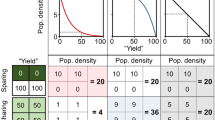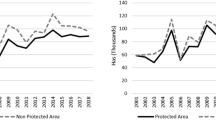Abstract
A heuristic solution method to identify a predefined number of cells in raster maps optimizing both multiple intrinsic cell characteristics and cell patch compactness (Vanegas et al. in Lect. Notes Comput. Sci. 5072:389–404, 2008), is extended so that also spatial interaction is taken into account. Spatial interaction is e.g., present in the flow of sediment between cells in a rasterised watershed as modified by the presence or absence of tree cover in a given cell. The resulting HLC-method is elaborated and tested in the context of a site location problem for reforestation in which the following criteria are considered: (1) the sediment flow reaching the outlet of the watershed is minimized, (2) two intrinsic environmental performances of the cells are maximized/minimized, and (3) the selected cells form a compact patch. To evaluate the performance of the HLC, its results are compared to the ones obtained with an Integer Programming (IP) formulation. This comparison suggests that the HLC identifies high quality, near-to-optimal patches of cells and that its computational efficiency makes it applicable to regional sized cases.
Similar content being viewed by others
References
Abdul-Rahman, A., & Pilouk, M. (2008). Spatial data modelling for 3D GIS. Berlin: Springer.
Bogaart, P. W., Torfs, P., & Troch, A. (2006). A multiple flow direction algorithm for computing intra hillslope length maps. Geographical Research Abstracts, 8.
Brookes, C. J. (2001). A parameterized region growing program for site allocation on raster suitability maps. International Journal of Geographical Information. Science, 11, 375–396.
Church, R., Gerrard, R., Gilpin, M., & Stine, P. (2003). Constructing cell-based habitat patches useful in conservation planning. Annals of the Association of American Geographers, 93, 814–827.
Church, R., & ReVelle, C. (1974). The maximal covering location model. Regional Science Association, 32, 101–118.
Church, R. L., Stoms, D., Davis, F., & Okin, B. J. (1996). Planning management activities to protect biodiversity with a GIS and an integrated optimization model. In proceedings of the 3rd international conference/workshop on integrating GIS and environmental modeling.
Coulthard, T. J., Kirkby, M. J., & Macklin, M. G. (1999). Modelling the impacts of Holocene environmental change in an upland river catchment, using a cellular automata approach. In Fluvial process and environmental change (pp. 31–46). New York: Wiley.
Coulthard, T. J., Macklin, M. G., & Kirkby, M. J. (2002). A cellular model of holocene upland river basin and alluvial fan evolution. Earth Surface Processes and Landforms, 27, 269–288.
Di-Gregorio, S., & Serra, R. (1999). An empirical method for modelling and simulation some complex macroscopic phenomena by cellular automata. Future Generation Computer Systems, 657, 1–13.
Dimopoulou, M., & Giannoikos, I. (2001). Spatial optimization of resources deployment for forest-fire management. International Transactions in Operational Research, 8, 523–534.
D’Ambrosio, D., Di-Gregorio, S., Gabriele, S., & Gaudio, R. (2001). A cellular automata for soil erosion by water. Physics and Chemistry of the Earth, 26, 33–39.
Egenhofer, M. J. (1989). A final definition of binary topological relationships. Lecture Notes in Computer Science, 367, 457–472.
Failfield, J., & Leymarie, P. (1991). Drainage networks from grid digital elevation models. Water Resources Research, 27, 709–717.
Fischer, D. T., & Church, R. L. (2003). Clustering and compactness in reserve site selection: an extension of the biodiversity management area selection model. Forest Science, 49, 555–565.
Hof, J., & Bevers, M. (2000). Direct spatial optimization in natural resource management: four linear programming examples. Annals of Operation Research, 95, 67–91.
Maceachren, A. M. (1985). Compactness of geographic shape: comparison and evaluation of measures. Geografiska Annaler, 67, 53–67.
Molina, A., Govers, G., Poesen, J., Van Hemelryck, H., De Bievre, B., & Vanacker, V. (2008). Environmental factors controlling spatial variation in sediment yield in a central Andean mountain area. Geomorphology, 98, 176–186.
Murray, A. B., & Paola, C. (1994). A cellular model of braided rivers. Nature, 371, 54–57.
Openshaw, S. (1996). Developing GIS-relevant zone-based spatial analysis methods. In P. Longley & M. Batty (Eds.), Spatial analysis: modelling in a GIS environment (pp. 55–74).
Parsons, J. A., & Fonstad, M. A. (2007). A cellular automata model of surface water flow. Hydrological Processes, 21, 2189–2195.
Qin, C., Xhu, A. X., Pei, T., Li, B., Zhou, C., & Yang, L. (2007). An adaptive approach to selecting a flow-partition exponent for a multiple-flow-direction algorithm. International Journal of Geographical Information Science, 21, 443–458.
Shirabe, T. (2004). Modeling topological properties of a raster region for spatial optimization. In Proceedings of the 11th international symposium on spatial data handling.
Stevens, D., Dragicevic, S., & Rothley, K. (2006). icity: a GIS-ca modelling tool for urban planning and decision making. Environmental Modelling & Software, 22, 1–13.
Tobler, W. (1979). Cellular geography. In Philosophy in geography (pp. 379–386). Dordrecht: Riedel.
Vanegas, P., Cattrysse, D., & Van-Orshoven, J. (2008). Comparing exact and heuristic methods for site location based on multiple attributes: an afforestation application. Lecture Notes in Computer Science, 5072, 389–404.
Vanegas, P., Cattrysse, D., & Van-Orshoven, J. (2009). Compactness and flow minimization requirements in reforestation initiatives: an integer programming formulation. Lecture Notes in Computer Science, 5592, 132–147.
Vanegas, P., Cattrysse, D., & Van-Orshoven, J. (2009). Integer programming (ip) formulation for minimizing sediment delivery in a watershed by reforestation of optimal sites. In 17th international conference on geoinformatics, Fairfax, USA. New York: IEEE Press.
Vanegas, P., Cattrysse, D., & Van-Orshoven, J. (2009). Spatial interaction model for locating cells minimizing flow. Technical report, Katholieke Universiteit Leuven, Centre for Industrial Management.
White, R., & Engelen, G. (2000). High-resolution integrated modelling of the spatial dynamics of urban and regional systems. Environment and Urban Systems Computers, 24, 383–400.
Wijffels, A., & Van Orshoven, J. (2009). Contribution of afforestation and reforestation to the enhancement of physical and socio-economic land performance in the southern Andes of Ecuador: assessment, modelling and planning support. Technical report, Vlaamse Interuniversitaire Raad (VLIR).
Williams, J. C. (2001). A linear-size zero-one programming model for the minimum spanning tree problem in planar graphs. Networks, 39, 53–60.
Williams, J. C. (2002). A zero-one programming model for contiguous land acquisition. Geographical Analysis, 34, 330–349.
Wolock, D. M., & McCabe Jr., G. J. (1995). Comparison of single and multiple flow direction algorithms for computing topographic parameters in top model. Water Resources Research, 31, 1315–1324.
Xiao, N. (2006). An evolutionary algorithm for site search problems. Geographical Analysis, 38, 227–247.
Author information
Authors and Affiliations
Corresponding author
Rights and permissions
About this article
Cite this article
Vanegas, P., Cattrysse, D., Wijffels, A. et al. Compactness and flow minimization requirements in reforestation initiatives: a heuristic solution method. Ann Oper Res 219, 433–456 (2014). https://doi.org/10.1007/s10479-011-0874-7
Published:
Issue Date:
DOI: https://doi.org/10.1007/s10479-011-0874-7




